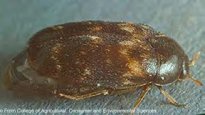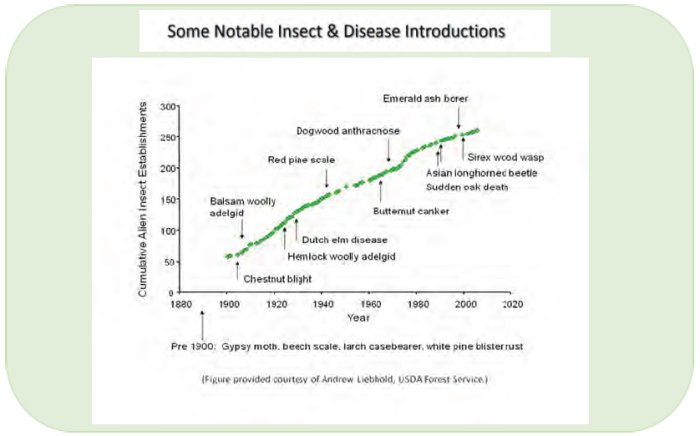AgEBB-MU CAFNR Extension
Green Horizons
Volume 24, Number 1
Winter 2020
Pest Patrol
The Hitchhiker's Guide to Invasive Pests
By Sarah Phipps | Missouri Department of Agriculture
My grandfather used to pick up hitchhikers as he drove countless miles along highway roads for his work in the 1950's and 60's. He worked as an entomologist with the United States Department of Agriculture and he was on the road a lot! I'm not sure if he picked up the wayward traveler to break up the monotony of the drive or to lend a helping hand... probably a little of both.
 |
Adult khapra beetle, Image from: http://www.acgov.org/ |
While he welcomed hitchhikers into his work sedan, he combated a different type of hitchhiker for his job - invasive pests. He worked with many invasive pests that were always looking to hitch a ride to somewhere new! He worked with the notorious khapra beetle, a grain hobo, the Japanese beetle that hitchhikes on plant material and soil, and the indiscriminate gypsy moth that glues its egg masses on any item found outdoors and truly do hitchhike on our cars and trucks.
 |
Male (left): female (right) gypsy moths, Image from: https://www.aphis.usda.gov/ |
As Europeans started coming to America, so did the pests, arriving in the ships' ballast water and in the settlers' supplies. Since those days, the ability for insect interlopers has exponentially increased due to the continuous growth of global trade and containerized shipping. U.S. Customs and Border Protection reports that each year the United States receives more than 11 million maritime containers at our seaports, 11 million by truck, and 2.7 million by rail. The impact has been pronounced. Along with the shipping containers comes many unwelcomed pests: wood borers burrowed into the wood pallets, weed seeds cling to the side and snails glide along. More than 450 nonindigenous forest insects and at least 16 pathogens have colonized United States' forest and urban trees since European settlement. At least 14% of these insects and all 16 pathogens have caused notable damage to trees.
 |
Japanese beetle, Image from: https://www.iowapublicradio.org/ |
As these invasive pests establish themselves, so does their ability to spread. I remember my grandfather telling me, with a reminiscent chuckle, that he wouldn't pick up hitchhikers today due to safety concerns. How times change! What was once a common practice of picking up a hitchhiker is now considered dangerous and is outlawed in many states.
Rules and ideas are also changing about hitchhiking pests. Moving firewood or plant material from state to state was once considered a relatively safe practice. Now as hitchhiking pest risks increase and more pests are establishing a population, it makes it easier for a pest to be transported from one location to another. Our vehicles, boats, boots, clothing and firewood are just a few of the modes of transport these invaders use to their advantage.
Behaviors must change to prevent invasive pests from hitchhiking across the country on you, me and our belongings. As people witness the Japanese beetle attacking their favorite roses or someone cutting down yet another dead ash tree due to the emerald ash borer, people are witnessing firsthand the consequences of invasive pests. Organizations are forming to bring increased awareness of such movement and they are focusing their message toward hikers, boaters, campers and travelers. People are considering new types of questions: did you inspect your vehicle when moving out of the gypsy moth quarantined area, did you wipe your boat down to prevent movement of zebra mussels, did you buy your firewood where you plan to burn it, did you use the boot brush to wipe off the mud and weed seeds from your boots?
 |
If you would like to learn more, check out some of these organizations:
- Don't Move Firewood: https://www.dontmovefirewood.org/
- Play Clean Go: https://www.playcleango.org/help-stop-invasive-species-with-playcleango
- Hungry Pests (USDA): https://www.aphis.usda.gov/aphis/resources/pests-diseases/hungry-pests/
- Tread Lightly: https://www.treadlightly.org/
- Leave No Trace: https://lnt.org/
- Don't Pack a Pest (Customs and Border): https://www.dontpackapest.com/
- Plant Heroes: https://plantheroes.org/
